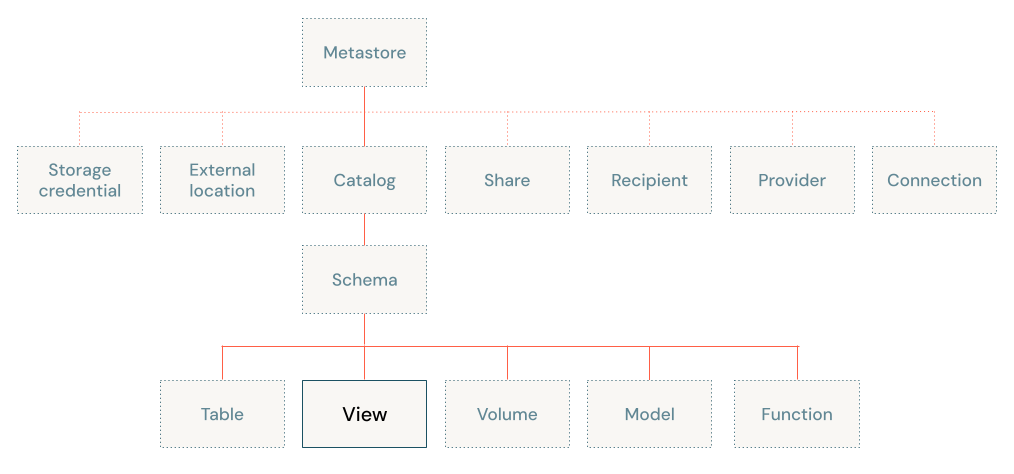What is a view?
A view is a read-only object that is the result of a query over one or more tables and views in a Unity Catalog metastore. You can create a view from tables and from other views in multiple schemas and catalogs.
This article describes the views that you can create in Databricks and provides an explanation of the permissions and compute required to query them.
For information about creating views, see:
Views in Unity Catalog
In Unity Catalog, views sit at the third level of the three-level namespace (catalog.schema.view):

A view stores the text of a query typically against one or more data sources or tables in the metastore. In Databricks, a view is equivalent to a Spark DataFrame persisted as an object in a schema. Unlike DataFrames, you can query views from anywhere in Databricks, assuming that you have permission to do so. Creating a view does not process or write any data. Only the query text is registered to the metastore in the associated schema.
Note
Views might have different execution semantics if they’re backed by data sources other than Delta tables. Databricks recommends that you always define views by referencing data sources using a table or view name. Defining views against datasets by specifying a path or URI can lead to confusing data governance requirements.
Materialized views
Materialized views incrementally calculate and update the results returned by the defining query.
You can define materialized views as part of a Delta Live Tables pipeline. See What is Delta Live Tables?.
Temporary views
A temporary view has limited scope and persistence and is not registered to a schema or catalog. The lifetime of a temporary view differs based on the environment you’re using:
In notebooks and jobs, temporary views are scoped to the notebook or script level. They cannot be referenced outside of the notebook in which they are declared, and no longer exist when the notebook detaches from the cluster.
In Databricks SQL, temporary views are scoped to the query level. Multiple statements within the same query can use the temp view, but it cannot be referenced in other queries, even within the same dashboard.
Dynamic views
Dynamic views can be used to provide row- and column-level access control, in addition to data masking. See Create a dynamic view.
Views in the Hive metastore (legacy)
You can define legacy Hive views against any data source and register them in the legacy Hive metastore. Databricks recommends migrating all legacy Hive views to Unity Catalog. See Views in Hive metastore.
Hive global temp view (legacy)
Global temp views are a legacy Databricks feature that allow you to register a temp view that is available to all workloads running against a compute resource. Global temp views are a legacy holdover of Hive and HDFS. Databricks recommends against using global temp views.
Requirements for querying views
To read views that are registered in Unity Catalog, the permissions required depend on the compute type, Databricks Runtime version, and access mode:
For all compute resources, you must have
SELECTon the view itself,USE CATALOGon its parent catalog, andUSE SCHEMAon its parent schema.To access views using single user access mode, you must also have
SELECTon all tables and views that are referenced by the view, in addition toUSE CATALOGon their parent catalogs andUSE SCHEMAon their parent schemas.